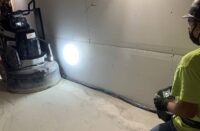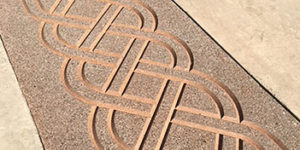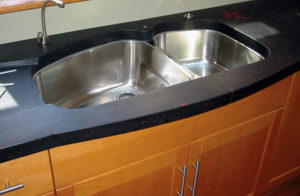Do a paid demo for polishing jobs
When bidding on a job for polished concrete, always look to do a paid demo. This will give your team an opportunity to survey the jobsite before the job begins so they can note anything that could hinder their job performance. Being able to get a feel for the concrete being used in the project will help to determine which diamonds to use and which matrix bonds you will need for the job. Based on this, you can more accurately calculate the amount of time you will need to spend grinding and polishing the concrete to achieve the spec the bid calls for.
Choosing the correct diamonds also will ensure your final bid number is more accurate. All of these factors will help in zeroing in on a solid, fair number for doing the job. The last thing it will do, and probably the most important thing, is help manage the customers’ expectations on the final product.
Make pool deck cleanup easier with poly protection
Here is an old trick, but one that is still very helpful. A lot of pool deck jobs are done during the height of pool season because of the good weather. If you find yourself doing one of these jobs, you can use a 6-mil poly to protect the pool water when working on the pool deck.
Lay the poly directly on the water, like placing a bed sheet on a bed, tape the edges to the pool and cut away the excess. This will help catch debris from the job and help keep the water clean. At the end of the job it will take several hands to lift the poly with the debris. This will help with the pool cleaner cost before the job is turned back over to the customer.
Try higher-grit diamonds for hard-to-remove epoxies, sealers
Having a hard time removing an epoxy or hard sealer? When your removal job has gone bad, try a higher-grit metal-bond diamond abrasive. Although everything you know says to use an aggressive, lower-grit diamond to remove the stubborn coating, a higher-grit diamond will add more raw diamond content to the floor.
With the raw diamond being smaller in size, it will dig in a little deeper and run at a much cooler temperature during the process. Try using a 70g or 80g metal-bond diamond next time. The results may surprise you.
Store tools in milk crates
We all have experienced headaches over how to store, move and keep our diamond abrasives and tools together. The simplest method I have discovered is to use old milk crates. These have built-in handles and can be stacked very easily.
Milk crates are constructed from a very thick and durable plastic that can stand up to the abuse of jobsite conditions and employees who can be rough with them while working. I also have found they can be screwed into wood stringers on the inside of a truck or trailer and used for instant shelving.
Have a problem with stuck screws?
Who hasn’t had a problem with getting the screws out of tool plates? These could be screws that secure diamonds, PCDs or carbide inserts. My solution? Bar soap.
Go to a local store and get a small plastic bar-soap holder and a cheap bar of soap. When you change out a tool, take the screw and scrape a little bar soap on the tip and securely screw it into place. The soap will coat the threads, making removal much more manageable. No more stuck and rusty screws. (Note: For those of you who use a commercial-based thread-locker product on your tooling, please follow all manufacturer specs and instructions.)
A clean mop and bucket works every time
If you use a sodium- or potassium-based densifier, you understand how important the cleanup process is after densification. A clean commercial mop and bucket can be used to dilute the reaction at the surface, especially along the edges. It is essential for you to clean hard-to-reach areas and the edges where the concrete and walls meet. Do not rely on a squeegee and shop vac. A mop and bucket is a crude but very effective tool.















